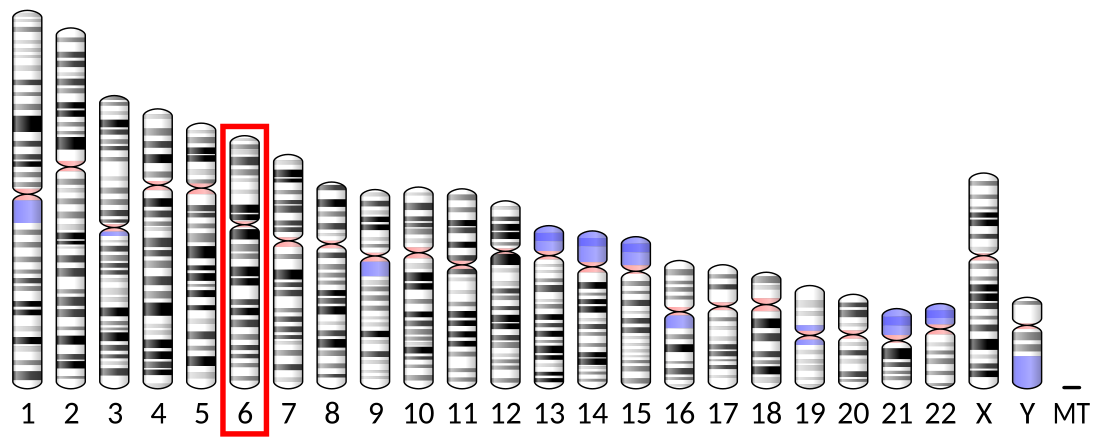Top Qs
Timeline
Chat
Perspective
Dysbindin
Protein From Wikipedia, the free encyclopedia
Remove ads
Dysbindin, short for dystrobrevin-binding protein 1, is a protein constituent of the dystrophin-associated protein complex (DPC) of skeletal muscle cells. It is also a part of BLOC-1, or biogenesis of lysosome-related organelles complex 1.In humans, dysbindin is encoded by the DTNBP1 gene.[5]
Remove ads
Discovery
Dysbindin was discovered by the research group of Derek Blake via yeast two-hybrid screening for binding partners of α-dystrobrevin.[5]
Tissue distribution
Dysbindin is found in neural tissue of the brain, particularly in axon bundles and especially in certain axon terminals, notably mossy fiber synaptic terminals in the cerebellum and hippocampus.[5]
Structure
Dysbindin is a coiled-coil-containing protein that serves as a core, stable component of the biogenesis of lysosome-related organelles complex 1 (BLOC-1), a multisubunit complex involved in intracellular protein trafficking and synaptic function.[6][7][8] Structurally, dysbindin engages in direct interactions with other BLOC-1 subunits—pallidin, snapin, and muted—primarily through a 69-residue region that forms coiled-coil domains, which are critical for complex assembly and stability.[8][6] Dysbindin’s sequence does not share significant identity with proteins of known function outside BLOC-1, but its acidic C-terminal region is homologous to domains found in other regulatory proteins, suggesting a role in recruiting or scaffolding additional protein partners (PMID 16533041).[8] Within neurons, dysbindin and its BLOC-1 partners localize to endosomal and synaptic compartments, where they regulate the trafficking of synaptic vesicle proteins and surface expression of neurotransmitter receptors, processes fundamental to synaptic plasticity and neurotransmission.[6][7]
Function
Dysbindin is a multifunctional regulatory protein highly expressed in the brain, where it plays a critical role in synaptic function, neurotransmitter release, and cognitive processes. As a core component of the biogenesis of lysosome-related organelles complex 1 (BLOC-1), dysbindin is essential for the trafficking of synaptic vesicle proteins and the regulation of receptor surface expression, particularly dopamine D2 receptors in cortical neurons.[9] Reduced dysbindin expression leads to increased surface D2 receptor levels and altered excitability of prefrontal cortical microcircuits, effects that have been linked to cognitive deficits and the pathophysiology of schizophrenia.[9][10][11] Additionally, dysbindin is involved in the regulation of glutamatergic and GABAergic neurotransmission, synapse formation, and maintenance, further underscoring its importance in neurodevelopment and synaptic plasticity.[10][11]
In drosophila, dysbindin has been shown to be essential for neural plasticity.[12]
Remove ads
Clinical significance
Summarize
Perspective
Interest in dysbindin has grown from pedigree-based family association studies of schizophrenia, which found a strong correlation between a particular dysbindin allele and the clinical manifestation of the disease.[13] However, this genetic link has not been consistently replicated across all case-control samples, suggesting that different genetic subtypes of schizophrenia, with varying disease allele frequencies, exist in different populations. This phenomenon, known as genetic locus heterogeneity, is common among complex disorders with strong genetic components. Compounding this complexity, it is likely that multiple distinct mutations within the dysbindin gene contribute to schizophrenia. This situation, known as disease allele heterogeneity, helps explain why different markers in the dysbindin gene show associations in different study populations.
Although the precise mechanisms by which dysbindin contributes to brain dysfunction are not fully understood, evidence suggests functional consequences. One study reported that schizophrenia patients carrying a high-risk dysbindin haplotype exhibited deficits in visual processing.[14] Another study demonstrated that reduced expression of DTNBP1 led to increased cell surface levels of dopamine D2 receptors, implicating dysbindin in dopaminergic signaling regulation.[15]
In addition to its role in schizophrenia, mutations in the DTNBP1 gene have been shown to cause Hermansky–Pudlak syndrome type 7.[16]
Remove ads
Interactions
Dysbindin has been shown to interact with SNAPAP,[17] MUTED[17] and PLDN.[17]
References
External links
Wikiwand - on
Seamless Wikipedia browsing. On steroids.
Remove ads




